Some of this year’s hottest emerging-market trades from bullish bets on the Brazilian real to surging AI-linked equities are starting to flash warning signs as fund managers highlight growing risks tied to overcrowded positioning.
Wells Fargo Securities cautions that valuations across Latin America’s currencies, which have been among 2025’s strongest carry-trade performers, look increasingly disconnected from underlying fundamentals. Fidelity International is raising alarms about thinner, less liquid African markets that could be vulnerable if global volatility picks up. Meanwhile, Lazard Asset Management is staying defensive after the sharp tech-stock selloff across Asia in early November the region’s steepest decline since April.
“Investors are becoming too relaxed about emerging markets,” said Brendan McKenna, emerging-market economist and FX strategist at Wells Fargo in New York. “Most, if not all, EM currencies look overstretched and are overlooking plenty of risks lingering in the background. They may still perform in the short term, but I think a pullback is ultimately unavoidable.”
That cautious stance isn’t misplaced. Many pockets of the developing-world investment landscape now appear overheated after a potent mix of Federal Reserve rate cuts, a softer dollar, and booming AI appetite fueled outsized returns. The same inflows that pushed markets higher could now spark abrupt reversals potentially damaging broader risk sentiment and tightening liquidity across multiple asset classes.
A quarterly HSBC Holdings Plc survey of 100 investors overseeing a combined $423 billion in emerging-market assets showed a dramatic shift in positioning. As of September, 61% reported net overweight exposure to local-currency EM bonds a major jump from a net 15% underweight in June. An index tracking this debt category is on pace for its strongest annual return in six years.
Equities have been no exception. The MSCI Emerging Markets Index has risen every month through October its longest monthly winning streak in over 20 years. With nearly a 30% gain so far this year, the benchmark is heading toward its best annual performance since 2017’s 34% surge. But history offers a cautionary reminder: after that strong year, 2018 delivered a 17% slide as a more hawkish Fed, intensifying US-China trade tensions, and a stronger dollar weighed heavily on overcrowded EM equity, carry-trade, and local-bond positions.
“As we move toward year-end, there’s a real possibility that investors take profits on what has been a very successful 2025 trade, creating more FX volatility,” said Anthony Kettle, senior portfolio manager at RBC BlueBay Asset Management in London.
Asian equity markets recently offered a live demonstration of how quickly crowded trades can unwind. High-flying AI stocks across the region tumbled sharply earlier this month. While tech shares also retreated globally, analysts warn that certain Asian markets face outsized vulnerability because of their heavy index weighting toward the sector.
South Korea stands out in particular. The Kospi the world’s best-performing major equity benchmark in 2025 after surging nearly 70% suffered a sudden drop of more than 6% in a single session before recovering half those losses by the close. “Positioning in Korea’s AI-memory trade is extremely tight,” said Charu Chanana, chief investment strategist at Saxo Markets in Singapore.
At Lazard Asset Management, emerging-market equity manager Rohit Chopra has also turned more defensive following the tech selloff. “From a factor standpoint, lower-quality companies have been outperforming higher-quality names,” he noted. “Historically, this type of divergence doesn’t last, which suggests the risk of a reversal if positioning remains overly concentrated.” Chopra co-manages the Lazard Emerging Markets Equity Portfolio, which has gained 23% over the past three years outperforming 95% of peers, according to data.
Options markets indicate that traders are growing more cautious on the Brazilian real, which has delivered roughly 30% in carry-trade returns this year. Three-month risk reversals recently climbed to their highest level in four years.
The real is a textbook example of a crowded winning trade, according to Alvaro Vivanco, head of strategy at TJM FX. Renewed fiscal uncertainty in Brazil adds another reason for investors to take a more measured stance, he said. McKenna of Wells Fargo adds that other Latin American currencies including Chile’s, Mexico’s, and Colombia’s also appear “a bit overvalued.”
Data from the Bank for International Settlements shows the Colombian peso’s trade-weighted value at its highest in seven years, sitting one standard deviation above the decade-long average. Similarly, the Mexican peso is trading about 1.4 standard deviations above its 10-year norm.
Some frontier-market bonds have also benefited as global investors rotated away from US assets this year. But firms such as Fidelity International now warn that these markets could struggle if sentiment turns.
“The trades I find most concerning are the ones where a sudden rush to exit overwhelms the natural buyer base,” said Philip Fielding, a portfolio manager at Fidelity. Markets like Egypt, Ivory Coast, and Ghana “can become illiquid when volatility rises,” he added.
Fielding, lead manager of the $538 million Fidelity Emerging Market Debt Fund, has delivered a 12% return over the past three years outperforming 84% of peers, according to compiled data.

Subscribe to our newsletter!
As a leading independent research provider, TradeAlgo keeps you connected from anywhere.








